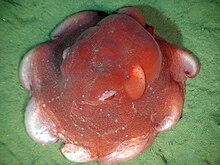Opisthoteuthis californiana
| Flapjack octopus | |
|---|---|
 |
|
| Scientific classification | |
| Kingdom: | Animalia |
| Phylum: | Mollusca |
| Class: | Cephalopoda |
| Order: | Octopoda |
| Family: | Opisthoteuthidae |
| Genus: | Opisthoteuthis |
| Species: | O. californiana |
| Binomial name | |
|
Opisthoteuthis californiana Berry, 1949 |
|
Opisthoteuthis californiana, also known as the flapjack octopus, is a species of octopus.
The flapjack octopus usually appears as transparent to dark red. Their maximum size is 20 cm mantle length. They have eight jointed legs which are affixed together in an umbrella shape. They have a gelatinous body, which spreads into a parachute shape when maneuvering through dimly lit water. The flapjack preys on small fishes and planktonic crustaceans. They swim by moving their fins, pulsing their webbed arms, pushing water through their funnel for jet propulsion, or all three at once. Their depth range is: Para-larvae 200m, adults 500-1500m.
This species has been reported off Eureka Bar, California, at 350 m. It is also known from Japan, off Kashima-Nada, at 530–560 m. Nesis (1982/87) reports it from the Bering Sea to the Sea of Okhotsk to off central Honshū in the northwestern Pacific and to off southern California in the northeastern Pacific.
The Opisthoteuthis californiana is one of 14 species in the Opisthoteuthis genus. These species are also known as the flapjack devilfishes.
Species of Opisthoteuthis are the most compressed, in the anterior-posterior axis, of any cephalopod. This flattened appearance gives them the common name of flapjack or pancake devilfish. Species are thought to be primarily benthic although they are capable of swimming and in some species the swimming may be an important component of their pouncing on minute prey. As in other cirrates, most species are poorly known.
...
Wikipedia
